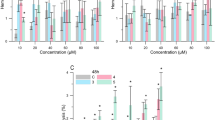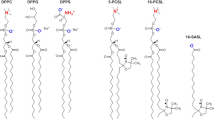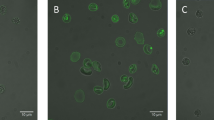Abstract
Recently, the effect of ligand receptor interaction on the membrane structure of liposomes has been studied extensively. However, little is known about how it exists on biological membranes. In this paper, the effect of Concanavalin A (ConA) receptor interaction on the structure of cell membranes was studied by Circular Dichroism (CD) and 31P Nuclear Magnetic Resonance (NMR).
CD results of both the purified macrophage membranes and human erythrocyte ghosts (EG) showed that the conformation of membrane proteins changed after ConA binding.
For further research, 31P-NMR was used to detect the organization of phospholipid molecules on macrophage membranes. After ConA binding, the tendency to form non bilayer structure increased with the amount of ConA. The changes of 31P-NMR spectra of living macrophages might be partly due to the above stated reason too.
In addition, ConA-receptor interaction also induced similar results of 31P-NMR spectra in EG. In contrast, wheat germ agglutinin (WGA), another kind of lectin, rarely showed the same influence.
Similar content being viewed by others
Introduction
During these years, considerable effort has been spent on trying to detect the non bilayer structures in biomembranes. Some organelle membranes are rich in lipids which have strong tendency to form H11 phases and have been studied 1. For example, endoplasmic reticulum membranes isolated from liver cells were studied with 31P NMR and some kind of non bilayer structures were identified 2. It has been found that partial dehydration of endoplasmic reticulum membranes leads to the appearance of H11 phase 3. Mitochondrial inner membranes are rich in cardiolipin which forms H11 phase in the presence of low levels of divalent ions4. Mg2+ions were found to induce lipidic particles (a kind of H11 phase) embedded between the two mono - layers of inner mitochondrial membranes 5. Furthermore, it was found that addition of millimolar amounts of Mn2+to intact mitochondria caused the appearance of regions of H11 phase6. Paracrystalline inclusions of H11 phase lipid domains were observed in frog retinal rod outer segments (ROS) by freeze-fracture electron microscopy 7. Another study had shown H11 phase cytoplasmic inclusions in rat retinal pigment epithelium under conditions of drug-induced lipidosis 8. Besides, it was reported that the structure of tight junction strands consists of pairs of lipid cylinders formed within linear fusion regions between adjacent cell membrane 9. Similarly, contact sites between the inner and outer membranes of Gram-negative bacteria may also involve non-bilayer lipid structures 10.
However, few reports had been focused on the structural changes of plasmic membranes of eukaryotic cells. Chemical fusogens had previously been reported to induce the formation of H11 structure in EG 11. But to our knowledge, little is yet known about the structural changes of cell membranes after ligand -receptor interactions.
In this paper, using CD and 31P-NMR, we demonstrated and discussed the interaction between ConA and membrane receptors and the possibility of non - bilayer structures in macrophage membranes, EG, and macrophages in the living state as well.
Materials and Methods
Kun Ming mice were obtained from the Dept. of Zoology, Beijing Medical University. Human erythrocytes were taken from the Beijing Red Cross Blood Center. ConA and WGA were purchased from SIGMA, USA. All other chemicals were of analytical grade.
Sample preparation
(1) Preparation of macrophage membranes
Purification of macrophage membranes was performed according to Chauvet's method 12. About 1×109 macrophages were homogenized in 26 ml of distilled water with a Dounce homogenizer. An equal volume of 60% (w/v) sucrose was then added and 45 ml (w/v) of this homogenate were gently layered on 36 ml of 45 % (w/v) sucrose. After 40 min centrifugation at 200×g, the upper layer and proteins at the boundary were decanted and again layered on 36 ml of 45% sucrose. Centrifugation was performed as above. The upper layer was again decanted and diluted with distilled water to obtain a final sucrose concentration of 20% (w/v). The cell fraction was then immediately centrifuged at 20,200×g for 1 hr. Macrophage membranes on the bottom of the tube were collected.
(2) Preparation of Erythrocyte ghosts
EG were prepared by a method adopted from Kornfeld 13. Erythrocytes were suspended in 0.9% NaCl -5 mM Tris -HCl buffer at pH 7.4, washed 3 times, and centrifuged at 1500 rpm for l0 min. The packed erythrocytes were hemolyzed in a 9 -fold volume of 10 mM Tris -0. I mM EDTA -HCl buffer, pH 7.4. Ghosts were washed 4 times by centrifugation at 20,000 × g for 20 min in 20 -fold volume of the Tris -EDTA -HCl buffer.
(3) Preparation of macrophages
Macrophages were obtained from the abdominal cavity of Kun Ming mice,and then suspended in D2O saline. The concentration of cells was about 1×109/ml.
ConA (or WGA) was added to the above samples to a certain concentration. After 10 min, centrifuged twice to remove the free ligand molecules.
CD measurement
CD spectrum was measured with a Jasco J -20C spectropolarimeter,at about 20°C and under constant nitrogen flush. Samples were contained in a 0.1 cm cell separately and scanned between 190 -250 nm. In CD experiments, a special kind of quartz cell which is only 0.1 cm thick was used to avoid the light scattering. Besides,we detected the structure changes at 222 nm, which is not significantly influenced by optical artifacts 14. Measurement was carried out in saline and the protein concentration was about 1 mg/ml. Data were expressed in terms of mean residue ellipticity [0].
31P - NMR measurement
31P - NMR measurements were performed at 20°C employing a Varian 300 MHz NMR spectrometer. Macrophage and erythrocyte membranes were added to saline to make the concentration of membrane proteins about 15 mg/ml. Then 0.5 ml membrane suspensions were added to a 5 mm NMR tube with 0.1 ml D2O. Macrophages in living state in D2O saline were directly added to a 5mm tube. Spectra were obtained from accumulated up to 10,000 transients.
Results
It has been reported that ConA can combine with special macrophage membrane receptors 15, 16. Our previous experiment using flow cytometry 17 also indicated that the amount of the combined ConA−receptor was related to the concentration of ConA.
Interaction of ConA -receptor in macrophage membrane
The effect of ConA−receptor interaction on purified macrophages were showed in Fig 1. After ConA binding, the conformation of membrane proteins changed with the amounts of ConA. The α -helix percentage was calculated according to Chen and Yang's method 18 (shown in Tab 1). It is known that most parts of ConA present in β -sheet structure and others are in random coil 19. So ConA itself does not make contribution to the percentage of α–helix of membrane proteins.
The effect of ConA−receptor binding on membrane lipid organization was further detected by 31P−NMR. Before ConA binding, the membrane lipids gave rise to an asymmetrical 31P−NMR lineshape with a high−field peak and a low−field shoulder, in agreement with that of a bilayer structure (Fig 2). While after ConA binding, the asymmetry reversed, giving a high−field shoulder and a low−field peak with an isotropic chemical shift of approximately 3−4 ppm (Fig 3).
Interaction of ConA receptor in living macrophages
By 31P NMR, we also studied the macrophages in living state. Before ConA binding, bilayer structure could be seen in the spectrum, but at low field a small peak was also distinguishable, most likely expressing the isotropic movement of intracellular phosphorus (Fig 4). After ConA binding, the high field peak decreased as the low field peak became higher (Fig 5). The formation of non bilayer structure may be one of the main reasons for this result.
Interaction of ConA receptor in EG
We also tried to find evidence in EG. In addition to ConA, another kind of lectin, WGA, was also used in our experiments.
CD results of EG showed that after ConA binding, the percentage of α–helix of membrane proteins decreased with ConA added (Fig 6). And a similar CD finding was seen after WGA binding (Fig 7). However, the percentage of α – helix of macrophage membrane proteins increased with the amounts of ConA (See Tab 1). The reason might be that ConA receptors in these two kinds of cells are different in structure.
31P-NMR spectra of EG before and after ConA binding showed similar results to those of macrophage membranes (Fig 8 & Fig 9). But after ConA binding, there was also a high−field peak which may be caused by the existence of partial regions of bilayer structure. In contrast, few changes of 31-PNMR could be seen before and after WGA binding (Fig 8 & Fig 10).
Discussion
From our experiments, it can be concluded that the larger the amounts of ConA, the more dramatic the change of the conformation of membrane proteins, and the easier the formation of non-bilayer spectra of 31P-NMR. Thus, ConA appears to affect the membrane structures mainly in a receptor-mediated way. Several important factors may be involved in this event.
First, the type of lectin may be an important factor, i.e. , the structure and function of the lectin. For example, ConA and WGA are different in structure and function, and may bring about different influences.
Secondly, an even more importanttactor, may be the membrane receptors, i.e. , its structure, location, total amount on membrane, and the mechanism and functional interaction of the lectin receptor. Glycophorin A (GPA), a kind of integral protein, is the receptor of WGA on erythrocyte membranes, while Band 3 protein is that of ConA. GPA and Band 3 protein are quite different both in structure and function. The amount and organization of GPA and Band 3 protein are also different. These may be the reason why the same amount of WGA in the same system did not yield the similar result as ConA did .
Thirdly, the content of non bilayer lipids which have the tendency to form non bilayer structures in the membranes is also an indispensible factor. It was reported that the content of PE in EG was more than 20% 20.
After ConA binding, the membrane receptors may aggregate into “patches”, thus removing the extensive bilayer stabilizing effect of the previously randomized protein molecules. As a result , large domains of lipids are freed from the influence of the protein and may spontaneously form non bilayer or intra-bilayer H11 phase. A small portion of the lipids will always remain associated with the protein and give rise to bilayer components presenting in the 31P NMR spectra of a high–field peak. In an elaborate study using fluorescent WGA, Ketis and Grant observed a phenomenon similar to “receptor patching” in a fluid system comprised of DMPC, GPA, and cholesterol, following addition of WGA 21. A previous study has showed that addition of WGA to GPA reconstituted liposomes of DOPE could induce a transition from bilayer to non bilayer structures22.
Non bilayer structure have been implicated as an important factor mediating the cellular events such as fusion, exo and endocytosis, and trans bilayer transport23. ConA is a kind of mitogen. It is reasonable to speculate that the ConA receptor mediated non bilayer Structure may induce similar changes of macrophage membranes to that occuring in activation or mitogenesis. It should be mentioned that the above idea is only hypothetical and further research should be carried out.
References
Seddon JM . Structure of inverted hexagonal (H11) phase, and non-lamellar phase transitions of lipids. Biochim Biophys Acta 1990; 1031:1–69.
de Kruijff B, van den Besselaar AMHP, Cullis PR, van den Bosch H, van Deenen LLM . Evidence for isotropic motion of phospholipids in liver microsomal membranes, a 31P -NMR study. Biochim Biophys Acta 1978; 514: 1–8.
Growe LM, Crowe JH . Hydration -dependent hexagonal phase lipid in a biological membranes. Arch Biochem Biophys 1982; 217: 582–7.
Rand RP, Sengupta S . Cardiolipin forms hexagonal structure with divalent cations. Biochim Biophys Acta 1972; 255: 484–92.
Green DE . Membrane proteins, perspective. Ann N Y Acad Sei 1972; 195: 150–72.
Venetie VR, Verkleij AJ . Possible role of non-bilayer lipids in the structure of mitochondria. Biochim Biophys Acta 1982: 692:397–405.
Corless JM, Costello MJ . Paracrystalline inclusions associated with the disc membranes of frog retinal rod outer segments. Exp Eye Res 1981; 32:217–28.
Buchheim W, Drenckhahn D, Lullmann- Rauch R . Freeze -fracture studies of cytoplasmic inclusons occurmg in experimental lipidosis as studied by amphiphilic cationic drugs. Biochin Biophys Acta 1979; 575: 71–81.
Kachar B, Reese TS . Evidence for the lipidic nature of tight junction strands. Nature 1982, 296: 464–6.
Lugtenberg B, van Alphen L . Molecular architecture and functioning of the outer membrane of E. coli and other Gram - negative bacteria. Biochim Biophys Acta 1983; 737: 51–115.
Hope MJ, Cullis PR . The role of nonbilayer lipid structures in the fusion of human erythrocytes induced by lipid fusogens. Bioehim Biophys Acta 1981; 640, 82–90.
Chawvet G . The purification of plasma membranes from guinea pig peritoneal macrophages. Adv Exp Med Biol 1979; 121:121–83.
Hamaguchi H . Cleve H . Solubilization of human erythrocyte membrane glycoproteins and separation of the MN glycoprotein from a glycoprotein with I. S. and activity, Biochim Biophys Acta 1972; 278: 217–80.
Glaser M, Singer SJ, Circular–dichroism and the conformations of membrane proteins. Studies with red blood cell membranes. Biochemistry 1971; 10:1780–7.
Pick S, Keisari Y . A simple colorimetric method for the measuremem of hydrogen peroxide produced by cells in culture. J Immunol Meth 1980; 38:161–70.
Yang KZ . The effectiveness of cetlls with immunological activity. Sci Press; 1986: 1–22.
Dai JW, Dong Q, Tao JP, Su YX Effect of ConA -receptor interaction on the microfilament assembly of macrophage, Acta Biophys Sin 1992; 8:18–21.
Chen YH, Yang JT, Martinez HM, Determination of the secondary structures of proteins by circular dichroism and optical rotatory dispersion. Biochemistry 1972; 11: 4120–31.
Sun C, Zhu Z, Mo HQ, Lectin. Sci Press; 1986: 35–6.
Jain MK . Introduction to Biological Membranes. John Wiley and Sons, Inc, USA, 1988; 107–8.
Ketis NV, Grant CWM . Control of high affinity lectin binding to an integral membrane glycoprotein in lipid bilayers. Biochim Biophys Acta 1980; 685: 347–54.
Theodore FT, Arnold TMS, de Kruijff B, Tellier C, Verkleij AJ . Lectin -receptor interaction in liposomes: evidence that binding of wheat getm aggulutinin to glycoprotein-phosphotidylethanolamine vesicles induces nonbilayer structures. Biochemistry 1982; 21: 5756–64.
Cullis PR, de Kruijff B . The polymorphic phase behaviour of phosphatidylethanolamines of natural and synthetie origin. Biochim Biophys Acta 1978; 513: 31–42.
Acknowledgements
We are grateful to Miss Du Hong and Mr Jiang Tianyi from the Dept of Biophysics and the National Research Lab of Natural and Biomimetic Drugs of Beijing Medical University for their kind help in the NMR measurements. This work was supported by a grant from the National Natural Science Foundation(No. 839700104).
Author information
Authors and Affiliations
Rights and permissions
About this article
Cite this article
Dai, J., Dong, Q., Su, Y. et al. Effect of ConA-receptor interaction on the structure of cell membrane. Cell Res 2, 129–137 (1992). https://doi.org/10.1038/cr.1992.13
Received:
Revised:
Accepted:
Issue Date:
DOI: https://doi.org/10.1038/cr.1992.13













